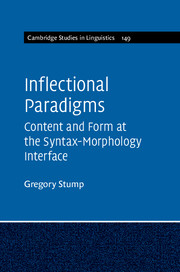Book contents
- Frontmatter
- Dedication
- Contents
- List of figures
- List of tables
- Acknowledgements
- List of abbreviations
- List of symbols and operators
- Introduction
- 1 What are inflectional paradigms?
- 2 Canonical inflectional paradigms
- 3 Morphosyntactic properties
- 4 Lexemes
- 5 Stems
- 6 Inflection classes
- 7 A conception of the relation of content to form in inflectional paradigms
- 8 Morphomic properties
- 9 Too many cells, too few cells
- 10 Syncretism
- 11 Suppletion and heteroclisis
- 12 Deponency and metaconjugation
- 13 Polyfunctionality
- 14 A theoretical synopsis and two further issues
- References
- Index
11 - Suppletion and heteroclisis
Published online by Cambridge University Press: 18 December 2015
- Frontmatter
- Dedication
- Contents
- List of figures
- List of tables
- Acknowledgements
- List of abbreviations
- List of symbols and operators
- Introduction
- 1 What are inflectional paradigms?
- 2 Canonical inflectional paradigms
- 3 Morphosyntactic properties
- 4 Lexemes
- 5 Stems
- 6 Inflection classes
- 7 A conception of the relation of content to form in inflectional paradigms
- 8 Morphomic properties
- 9 Too many cells, too few cells
- 10 Syncretism
- 11 Suppletion and heteroclisis
- 12 Deponency and metaconjugation
- 13 Polyfunctionality
- 14 A theoretical synopsis and two further issues
- References
- Index
Summary
In a realized paradigm of the canonical sort, all word forms share the same stem. It is nevertheless extremely common for a realized paradigm to exhibit two or more stems in alternation. In Section 5.2, we saw that when stem Y alternates with stem Z in a realized paradigm, the relation between Y and Z may be of three different kinds.
• Y and Z are sandhi alternants if principles of automatic phonology determine the choice between Y and Z. Distinctions between sandhi alternants needn't be represented at all in form paradigms, since they may be assumed to be introduced by the phonological component.
• Y and Z are class-determined (or kindred) stems if they form part of the inflectional pattern of a single inflection class. Within a form paradigm, different cells may have different stems provided that they are kindred stems.
• Y and Z are independent stems if their difference in form does not follow from their membership in a particular inflection class. Stems that are independent of each other but which realize the same lexeme may belong to the same inflection class or to different inflection classes. In either case, their alternation is suppletive; in the latter case, their alternation is additionally heteroclitic.
In this chapter, I examine paradigms exhibiting two or more independent stems in alternation. I begin with an overview of suppletive and heteroclitic alternations and of the ways in which such alternations may be conditioned (Section 11.1). In Section 11.2, I show how the paradigm-linkage hypothesis elucidates the properties of suppletion and heteroclisis, then focus attention on the implications of suppletion for morphological theory (Section 11.3).
Suppletive and heteroclitic alternations
Suppletion is an alternation between independent stems in a lexeme's paradigm. In the clearest cases, the alternating stems lack any phonological similarity; thus, go ∼ went, bad ∼ worse and be ∼ am ∼ are ∼ is ∼ was are textbook examples of suppletion. But suppletion may also be assumed to include stems which, though independent, nevertheless exhibit a partial similarity in form; thus, can ∼ could, was ∼ were and better ∼ best are also examples of suppletion, though of a slightly more subtle sort.
- Type
- Chapter
- Information
- Inflectional ParadigmsContent and Form at the Syntax-Morphology Interface, pp. 184 - 196Publisher: Cambridge University PressPrint publication year: 2015



